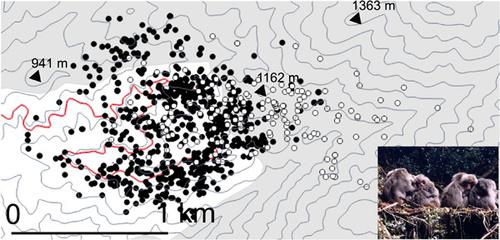当前位置:
X-MOL 学术
›
Am. J. Primatol.
›
论文详情
Our official English website, www.x-mol.net, welcomes your feedback! (Note: you will need to create a separate account there.)
Ranging patterns of Japanese macaques in the coniferous forest of Yakushima: Home range shift and travel rate.
American Journal of Primatology ( IF 2.4 ) Pub Date : 2020-08-13 , DOI: 10.1002/ajp.23185 Goro Hanya 1, 2 , Shin-Ichi Yoshihiro 3 , Shuhei Hayaishi 2, 4 , Yukio Takahata 5
American Journal of Primatology ( IF 2.4 ) Pub Date : 2020-08-13 , DOI: 10.1002/ajp.23185 Goro Hanya 1, 2 , Shin-Ichi Yoshihiro 3 , Shuhei Hayaishi 2, 4 , Yukio Takahata 5
Affiliation

|
Ranging is one of the most important behavioral adaptations for coping with seasonally fluctuating food and thermal conditions. We studied the ranging patterns, in particular home range shift and travel rate of Japanese macaques (Macaca fuscata) in the coniferous forest of Yakushima by tracking a group for 17 months. We also supplemented our data with records collected every August over a 5‐year annual census. The macaque group used the eastern part of their home range from May to September and the western part during the rest of the year. The eastern part of the home range was largely primary forest in the national park, and the altitude was higher than in the western part. When they used the western part, the macaques ate more herbs and fruits from small‐sized trees, the availability of which was higher in the logged forest. This east–west home range shift occurred repeatedly over multiple years. A neighboring group occupied the western part of the focal group's home range in summer, which the focal group did not use in that season. Both temperature and diet affected seasonal changes in the monthly average travel rate. Animals need more energy for thermoregulation when the temperature is low, so the macaques decreased their ranging efforts to save energy at times of low temperature. They increased their ranging distance to eat fungi, since their encounters with this food would increase with the total distance walked. They also increased their travel rate when eating flowers, which had lower food patch (tree) density than other foods such as fruits. The data supported the hypothesis that the macaques capitalize on habitat heterogeneity in a seasonally fluctuating habitat by shifting their home range and modifying their travel rate.
中文翻译:

日本屋猕猴在屋久岛针叶林中的分布模式:迁徙范围和行进速度。
测距是应对季节性波动的食物和温度条件的最重要的行为适应方式之一。我们研究了测距模式,特别是日本猕猴(Macaca fuscata)在屋久岛的针叶林中追踪一个小组17个月。我们还对数据进行了补充,在每年的5年年度普查中每年八月收集一次记录。猕猴小组在五月至九月使用了家园范围的东部,而在其余时间里则使用了西部。家园范围的东部主要是国家公园中的原始森林,海拔高度高于西部。当他们使用西部地区时,猕猴从小树上吃了更多的药草和水果,在砍伐的森林中它们的利用率更高。这种东西向范围变化在多年内反复发生。夏季,一个邻近的小组占领了该小组的家庭范围的西部,该小组在那个季节没有使用该小组。温度和饮食都会影响每月平均旅行率的季节性变化。动物在低温时需要更多的能量来进行温度调节,因此猕猴减少了在低温时节省能量的测距努力。他们增加了食用真菌的距离,因为与这种食物的接触会随着步行的总距离而增加。他们还提高了进食花朵的速度,花朵的花斑(树)密度比其他食物(例如水果)低。数据支持这样的假设,即猕猴通过改变其居所范围并修改其行进速度,利用了季节性波动的栖息地中的栖息地异质性。因此,猕猴减少了在低温时节省能源的测距工作。他们增加了食用真菌的距离,因为与这种食物的接触会随着步行的总距离而增加。他们还提高了进食花朵的速度,花朵的花斑(树)密度比其他食物(例如水果)低。数据支持这样的假设,即猕猴通过改变其居所范围并修改其行进速度,利用了季节性波动的栖息地中的栖息地异质性。因此,猕猴减少了在低温时节省能源的测距工作。他们增加了食用真菌的距离,因为与这种食物的接触会随着步行的总距离而增加。他们还提高了进食花朵的速度,花朵的花斑(树)密度比其他食物(例如水果)低。数据支持这样的假设,即猕猴通过改变其居所范围并修改其行进速度,利用了季节性波动的栖息地中的栖息地异质性。与其他食物(例如水果)相比,食物斑块(树木)的密度较低。数据支持这样的假设,即猕猴通过改变其居所范围并修改其行进速度,利用了季节性波动的栖息地中的栖息地异质性。其食物斑块(树)的密度低于其他食物(例如水果)。数据支持这样的假设,即猕猴通过改变其居所范围并修改其行进速度,利用了季节性波动的栖息地中的栖息地异质性。
更新日期:2020-09-20
中文翻译:

日本屋猕猴在屋久岛针叶林中的分布模式:迁徙范围和行进速度。
测距是应对季节性波动的食物和温度条件的最重要的行为适应方式之一。我们研究了测距模式,特别是日本猕猴(Macaca fuscata)在屋久岛的针叶林中追踪一个小组17个月。我们还对数据进行了补充,在每年的5年年度普查中每年八月收集一次记录。猕猴小组在五月至九月使用了家园范围的东部,而在其余时间里则使用了西部。家园范围的东部主要是国家公园中的原始森林,海拔高度高于西部。当他们使用西部地区时,猕猴从小树上吃了更多的药草和水果,在砍伐的森林中它们的利用率更高。这种东西向范围变化在多年内反复发生。夏季,一个邻近的小组占领了该小组的家庭范围的西部,该小组在那个季节没有使用该小组。温度和饮食都会影响每月平均旅行率的季节性变化。动物在低温时需要更多的能量来进行温度调节,因此猕猴减少了在低温时节省能量的测距努力。他们增加了食用真菌的距离,因为与这种食物的接触会随着步行的总距离而增加。他们还提高了进食花朵的速度,花朵的花斑(树)密度比其他食物(例如水果)低。数据支持这样的假设,即猕猴通过改变其居所范围并修改其行进速度,利用了季节性波动的栖息地中的栖息地异质性。因此,猕猴减少了在低温时节省能源的测距工作。他们增加了食用真菌的距离,因为与这种食物的接触会随着步行的总距离而增加。他们还提高了进食花朵的速度,花朵的花斑(树)密度比其他食物(例如水果)低。数据支持这样的假设,即猕猴通过改变其居所范围并修改其行进速度,利用了季节性波动的栖息地中的栖息地异质性。因此,猕猴减少了在低温时节省能源的测距工作。他们增加了食用真菌的距离,因为与这种食物的接触会随着步行的总距离而增加。他们还提高了进食花朵的速度,花朵的花斑(树)密度比其他食物(例如水果)低。数据支持这样的假设,即猕猴通过改变其居所范围并修改其行进速度,利用了季节性波动的栖息地中的栖息地异质性。与其他食物(例如水果)相比,食物斑块(树木)的密度较低。数据支持这样的假设,即猕猴通过改变其居所范围并修改其行进速度,利用了季节性波动的栖息地中的栖息地异质性。其食物斑块(树)的密度低于其他食物(例如水果)。数据支持这样的假设,即猕猴通过改变其居所范围并修改其行进速度,利用了季节性波动的栖息地中的栖息地异质性。



























 京公网安备 11010802027423号
京公网安备 11010802027423号